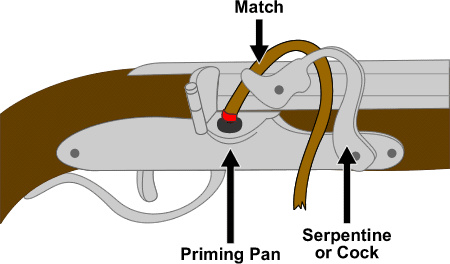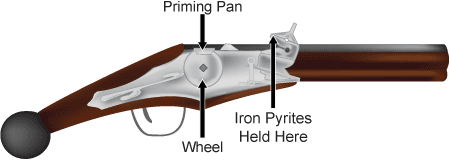“War, war never changes.”
–Ron Perlman, Fallout Intro.
Alas, much
like everything else in nature, in the manic quest for power over the eras,
conflict has become the heart of every major age. With man’s great intellect
constantly evolving, the nature of conflict amongst man evolved with it. The
tools of destruction that wrought the battlefields of the day were always on
the rise, always on the cutting edge.
And so, over the years, in order to
ensure the veritable security of his domain man needed a tool that will aid in
times of conflict. One that is able to swing the balance of power to their own
favor. In it, man was able to manipulate the very nature of war itself. No
armor could protect against it, nothing was fast enough to avoid it, and in its
arrival would literally rock the very foundations of the world it was created
in.
The age of the firearm had begun.
The history of the firearm dates
back to the conceptualization of one of its prime ingredients, the "magic dust"
from which it derives all its power. I speak, of course, of gunpowder.
Gunpowder was first developed in China around the 9th century.
However, military applications of this compound would never really be developed
until much later on (Klatt). Its original use was more for festive reasons in
the making of firecrackers and fireworks.
Around the 14th century,
the knowledge of gunpowder was supposedly spread from China to the Middle East
and Europe through the Silk Road (Norris, 2013). This is where the foundation
of the firearms we know today had their origin.
The first known iterations of
handheld, personal firearms used the Matchlock
system of firing. Burning matched/wicks are locked and released into a pan
of powder igniting a larger powder charge inside the barrel and propelling the
projectile forward (Klatt). Of course, such a design would no doubt be difficult to reload as the main powder charge, priming powder and the projectile had to be manually loaded for each shot.
 | |
| Taken from: Firearm Examiner Module, National Forensic Science Technology Center |
The next innovation in the firing mechanism came with the onset of the Wheel lock system. Matches were not the most reliable source of ignition, often easily succumbing to the forces of nature. This mechanism involved a spinning steel wheel that created sparks upon grinding against a flint that was held opposite it (Jones). The spark would then ignite a small pan of powder that would then, in turn, ignite the main powder charge inside the gun (Jones). It proved more reliable than the matchlock as it was more resistant to the change in conditions, but its complexity proved to be quite expensive and so it was not so favored in the eyes of military application (Jones).
 |
| Taken from: Firearm Examiner Module, National Forensic Science Technology Center |
What would reconcile both the problem of environmental reliability and cost of production was creation of the Flintlock design. It combined the inexpensive, simplicity of the matchlock system, whilst keeping the flint ignition of the previous wheel lock (Jones). The great innovation of this system cam with the implementation of the frizzen, which served to both ignite the flint and cover the exposed powder from environmental hazards (Hallowell, 2013). Its evolution was so great that it withstood nearly 200 years without change on the design (2013).
 |
| Taken from: HowStuffWorks,"The Flintlock Mechanism" |
The final innovation in the antique gun's firing mechanism came at around the 19th century with the Percussion Cap mechanism (Klatt). This mechanism completely redesigned the old flint and steel mechanic with the use of first, a hammer, that was used to strike a cap, that would ignite the powder charge inside the barrel (Klatt). Its design solved the problem of sealing the barrel from any environmental hazards as well as quickened the reloading of the firearm as the percussion cap was easily snapped on and removed for each shot (Jones).
 |
| Taken from: United States Department of Justice, Bureau of Alcohol, Tobacco, Firearms and Explosives |
These were the foundations of antique firearm technology for nearly four centuries. The next evolution of the firearm would entail the combination of all the things the previous generations tired to accomplish, in combining the primer, the powder and the projectile in one small casing. This is the birth of ammunition and the start of modern firearm technology as we know it.
Sources:
Brain, M. (2000). How Flintlock Guns Work. HowStuffWorks.
Retrieved March 9,
2014, from http://science.howstuffworks.com/flintlock2.htm
Firearms Verification. (n.d.). Firearms - Guides -
Importation & Verification of
Firearms, Ammunition - Gun Control Act Definitions - Antique
Firearm. Retrieved March 9, 2014, from
http://www.atf.gov/content/firearms/firearms-industry/guides/gun-control-act-definitions-antique-firearm
Hallowell,
B. (2013). The History and Evolution of Guns as Told Through
Pictures. The Blaze. Retrieved March 9, 2014, from
http://www.theblaze.com/stories/2013/03/12/the-history-and-evolution-of-guns-as-told-through-pictures/
Jones,
J. A. Propellants, firearms and ammunition development. National Forensic
Science Technology Center. Retrieved from
http://projects.nfstc.org/firearms/module03/fir_m03_t05_03.htm
Klatt,
E. (n.d.). History of Firearms. Firearms
Tutorial. Retrieved March 9,
2014, from http://library.med.utah.edu/WebPath/TUTORIAL/GUNS/GUNHIST.html
Norris,
J. (2003). Early gunpowder artillery: 1300-1600. (p. 11). Marlborough: The
Crowood Press.
Miguel Augusto A. Racadio
2013-59621
STS THX
STS THX
No comments:
Post a Comment